

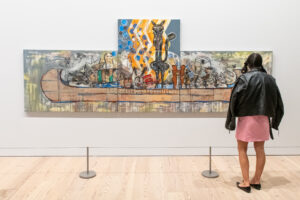
As we come into the installation of Jaune Quick- to- See Smith’s exhibition at the Whitney Museum, the first piece we encounter is the enormous Trade Canoe Forty Days and Forty Nights. 2015
named after the journey of Noah’s ark.
Trade canoes are a major theme in Smith’s work. In this exihbition we have eight, two actually built of pinewood lath with her son.
As an object in itself it can refer simply to a means of transportation and community connection (the importance and challenges of canoe journeys are now a prominent aspect of Northwest summers. Here is a report on the arrival of the canoes from all over the Northwest in Seattle n 2023, on Alki Beach, where the Denny party landed in 1850 greeted by Chief Seattle,)
But these trade canoes are already full to capacity with people, animals, trees, and imaginary creatures.
The artist states:
“Remember when the trade canoes came up river, they would be piled with bags of moldy flour, wormy beef, whiskey laced with lead and blankets smeared with smallpox” (p 21 Memory Map, interview with Lowery Stokes Sims)
So the trade canoes all suggest death related themes in some way.
Let us look at 40 Days and 40 Nights
It is impossible to take in all the details of even a single trade canoe and its contents. The larger theme is devastation of the land, the people, and the indigenous way of life that was stampeded by colonialism. A partner theme is the same colonial devastation is being perpetrated on the peoples of the Middle East.
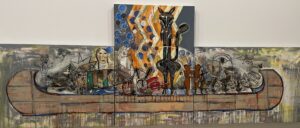
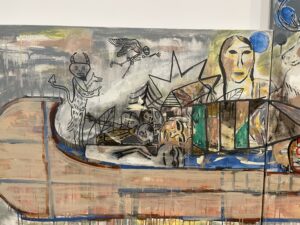
Left side ( bow??) we see the devil in outline;
above flies a winged calaveras ( where putti would be in baroque painting), a crowd of heads are collected one with a big “hat” like form
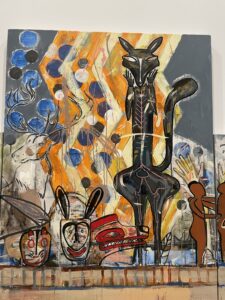
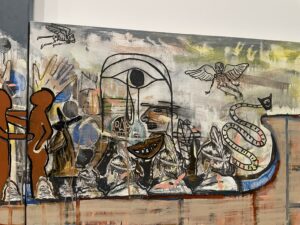
Center, Coyote part of Creation Myth, as well as trickster, near Coyote are various creatures, rabbit, eagle, deer. He is bathed in a shower of sun.
On the right we see two humans greeting each other and below a long row of cliche indian heads. A large picassoid head with one eye and a crooked mouth and a snake leaps up in the stern.
You can look at one of Smith’s paintings for a long time and not see everything.
She began the earliest canoe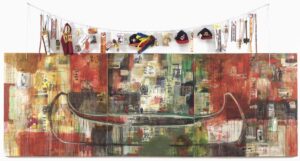
at the time of the 1992 celebration of Columbus arrival in 1492. Needless to say the arrival of Columbus was no cause for celebration among indigenous peoples. So this first canoe called Trade Gifts for Trading Lands with White People is full of amusing details, such as all the “gifts” strung across the top of the painting are Indian themed kitsch. Also the canoe has nothing in it unlike all her other canoes. and has no indication of front and back.
The canoe is suspended in a sea of collage that speaks to the abuses and contradictions of native life.
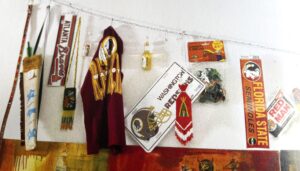
It is hard to see the collaged details in the painting, but they refer to various iconic images from the era of the Indian Wars such as Wi-jún-jon, Pigeon’s Egg Head (The Light) Going To and Returning From Washington, 1837-1839 by George Catlin. In this famous painting Catlin depicts the native Chief going to DC in his traditional regalia and returning with European clothes and whiskey bottles in his back pockets.
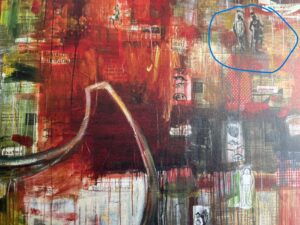
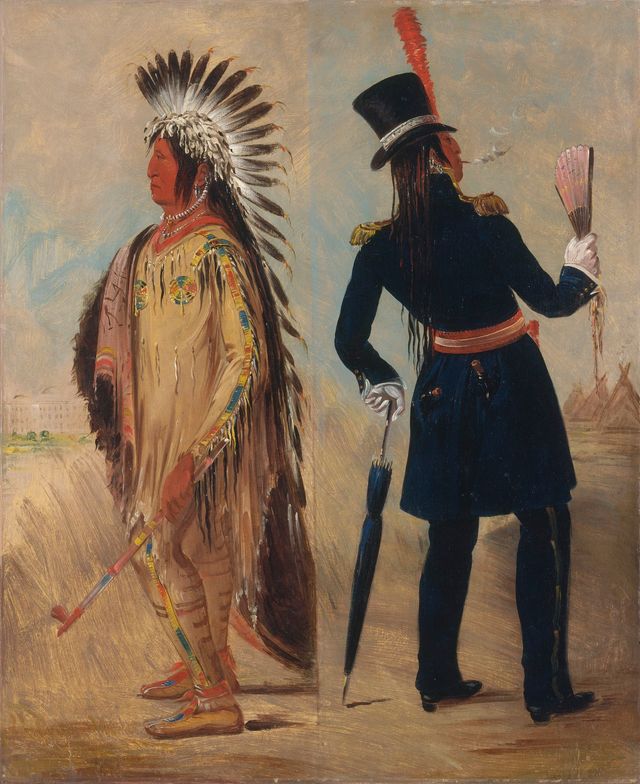
Tongass Trade Canoe 1996, another blockbuster painting refers to the bringing of oil drilling to the fragile Tongass National Forest, the calving land of the Caribou, whom we see galloping across the top of the painting. Above are laundry baskets suggesting a commodity that comes from oil drilling. The Tongass. after a decade of fighting, was finally protected in 2023 from development (we hope).
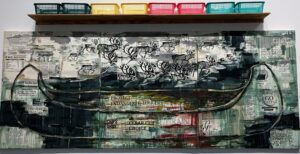
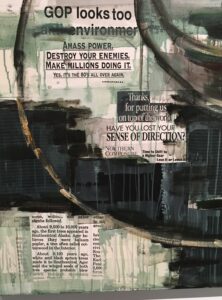
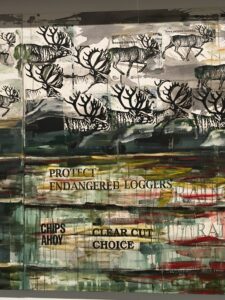
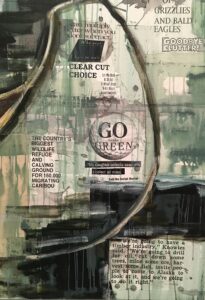
Here are more examples of trade canoes from the exhibition
Trade Canoe the Garden
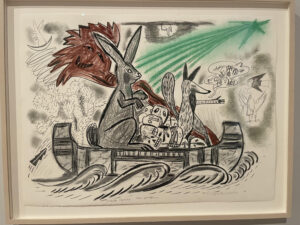
Trade Canoe Making Medicine with Neil Ambrose Smith
pinewood lath, plastic water bottles, styrofoam and paper coffee cusps, and take-out containers, wooden crosses, hypodermic needles, arcylic and synthetic sinew.
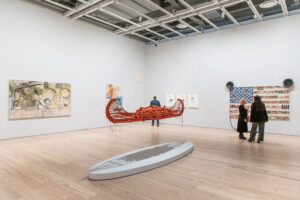
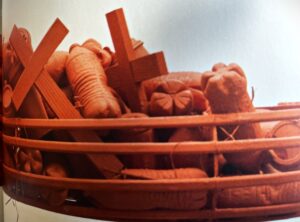
A detail of a second canoe Trade Canoe: Fry Bread 2018 pinewood lath, fry bread and synthetic sinew.
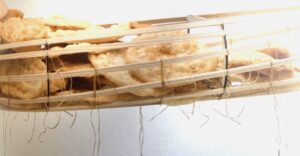
In other words one canoe has the detritus of consumption of a mainstream diet, the other has one staple of Indigenous food.
Trade Canoe for the North Pole What do you take when you have to leave everything. Smith humourously suggests Palm trees, but also a horse.
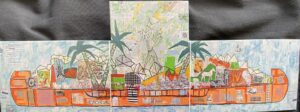
Trade Canoe False Gods
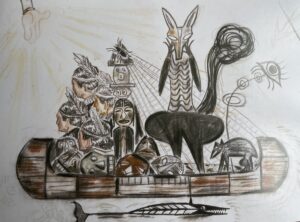
Trade Canoe: Don Quixote 2 details
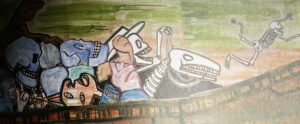
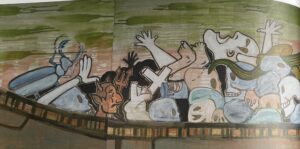
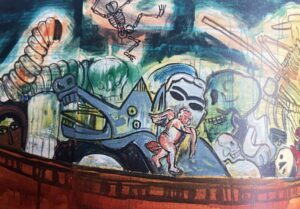
and Trade Canoe Don Quixote in Sumeria detail
Clearly we are seeing death and destruction, suffering, and chaos in these canoes. In the last, created in response to the Iraq war, we see a reference to a looted art work from the Baghdad Museum rubbing up against a skeleton, and a monster creature underneath that echoes Picasso.
One of Smith’s great accomplishments is to take on the big famous white artists and, in my opinion, outdo them at their own game adding much more meaning to the work. Picasso is one example.
The maps in the exhibition were initially inspired by Jasper Johns, but look where the artist goes with them. These are only three examples of many.
Indian Map
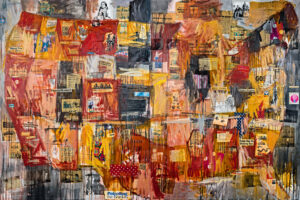
Memory Map
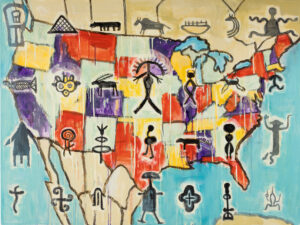
Homeland
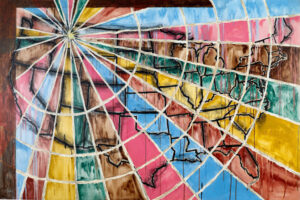
Look closely, the artist is from Montana in the upper left, there is a US map underneath, the radiating lines and colors create an entirely new dynamic.
Smith dismisses the traditional lines of US maps, the states, as arbitrarily cutting across Indian lands and tribes. In fact borders of any kind are arbitrary colonial demarcations.
Other icons in her work are horses
Going Forward Looking Back
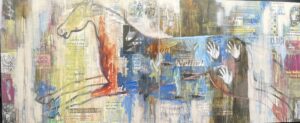
and buffalos
this painting is called Indian Drawing Lesson After Leonardo.
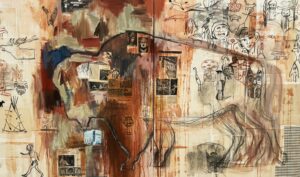
Again in the detail, you can see some famous Greek sculpture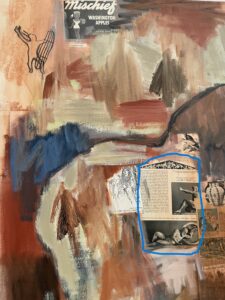
Smith’s show includes numerous icons, witticisms, re-ups of famous artists like Edward Kienholz
and Christianity with Indian Madonna Enthroned
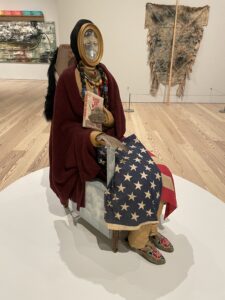
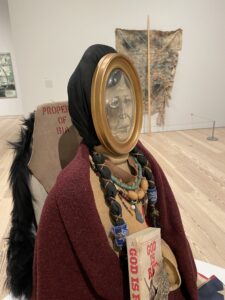
a whole series on General Custer, this is my favorite.
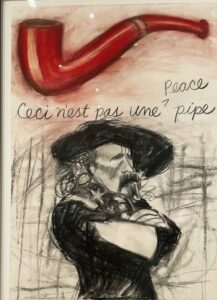
Send up of the thirst for Indian artifacts by white collectors
“Flathead Headdress collected by whites to decorate homes”
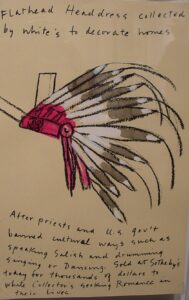
“After priests and US Government banned cultural ways such as speaking Salish and druming singing or dancing.
Sold at Sotheby’s today for thousands of dollars to white collector’s seeking Romance in their lives.”
One of Smith’s amazing talents is taking the dreadful and making it amusing even as we don’t lose sight of the horrors. I think this is called Indian humor.
Fortunately the exhibition is coming to Seattle in the spring, so I will get to write about it again with different perspectives. I feel as though I have barely begun.